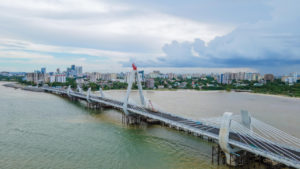by Ben Taylor
Tanzanite Bridge opens, connecting Oyster Bay and Dar city centre
On February 1, 2022, the Tanzanite Bridge opened to road users. The 1km-long bridge connects Oyster Bay (Kenyatta Road close to Toure Drive) to Dar es Salaam city centre (on Obama Drive formerly Ocean Road) by the Aga Khan Hospital. The bridge’s striking design and construction combines elements of a girder bridge and a cable-stayed bridge to make it lighter.
With four lanes (plus pedestrian sections) and a capacity of 55,000 vehicles per day, the bridge is expected to ease congestion on Ali Hassan Mwinyi Road, which handles at least 42,000 vehicles every day. In particular, it will reduce pressure on the bottleneck point of Selander Bridge, originally constructed across the Msimbazi delta in 1929 and replaced in 1980.
The TSh 256 bn (USD $127m) cost of the bridge has been jointly provided by the Tanzania government (17%) and a loan from the government of South Korea (83%).
The government said the bridge is significant in efforts to address the challenge of traffic congestion in Dar es Salaam. Minister of Works, Transport and Communications, Makame Mbarawa, said the chronic traffic congestion forced the government to come up with plans that included construction of roads and bridges in order to reduce, if not eliminate, the challenge.
Republic of Korea Ambassador to Tanzania, Kim Sun Pyo, said the project will stand as a symbol of success and cooperation between the two countries.
The bridge makes a bold addition to the skyline of Dar es Salaam, and has drawn praise from many. “Magnificent Tanzanite Bridge amazes city dwellers,” read the headline in the Daily News.
A motorcyclist, Richard Waniga told the same paper that he rode all the way from Kigamboni to witness the opening of the bridge. “I reside in Kigamboni; I just came to see the new bridge across the Indian Ocean… it is attractive, I commend the government for completing this project.”
Media commentator, Maggid Mjengwa, posted on Facebook that he was definitely the first person to cross the new bridge by bicycle.
Writing in The Citizen, commentator Charles Makakala offered praise for the bridge’s design. It is “an iconic structure,” he wrote, and “a work of beauty merging contemporary engineering with superb aesthetics.” He also noted that it is “expected to be popular with tourists too, who may wish to pass through and take memorable photos of their stay in the city.”
Nevertheless, Makakala also questioned the rationale behind the bridge. He argues that the money would have been better spent widening Ali Hassan Mwinyi Road by building a second bridge alongside the existing Selander Bridge – that this would have been considerably cheaper. He adds that a bridge further upstream, connecting Kinondoni Hananasif and East Upanga near Muhimbili National Hospital, would have made more sense. And indeed he questions whether the continuous expansion of Dar es Salaam road networks should be top priority, when improvements to public transport services desperately need investment and when the government is in the process of relocating to Dodoma.
He concludes that we would be wise “to follow the money”. In particular, he notes that the bridge will significantly raise the value and use of land in Msasani.
Agreement signed on Burundi rail link
In January, the governments of Tanzania and Burundi signed an agreement to construct a standard gauge railway between Uvinza in Kigoma to Burundi’s town of Gitega. The 282km line is expected to cost USD $900m. Finance and transport ministers from the two countries signed the deal in Kigoma.
On the part of Tanzania, the project would involve connecting Uvinza-Malagarasi railway section (156km) whereas Burundi would start from Malagarasi to Musongati-Gitega (126km). Finance and Planning Minister Dr Mwigulu Nchemba said the project would lead to opening business opportunities not only between the two countries, but also for other neighbouring nations. He said the two governments have begun to look for sources of funds to finance the project.
Burundian Minister for infrastructures, Works and Settlements, Dr Deogratius Nsanganiyumwami, said the railway will help to transport over three million tonnes of minerals from Burundi and one million tonne of other cargo, a move which would help stimulate industrial growth, agriculture and economy at large.
Commentators applauded the agreement, arguing that the railway will play a major role in integrating markets and increasing trade, not only across Tanzania and Burundi but also beyond, and that this would help to unlock economic potential in these two nations.
Transportation expert, Prof Zacharia Mganilwa of the National Institute of Transport, noted that the agreement would mean that Burundian cargo from/to Dar es Salaam Port would be transported directly to or from the port by railway. “This helps to avoid cargo double handling which increases transport costs, something that goes further to increase prices of goods and services,” he explained. He added that transporting cargo via railway was also cheaper than road, a situation which would also contribute to decreasing transport costs.
Meanwhile, work continues on construction of the standard gauge railway (SGR) connecting Dar es Salaam, Morogoro, Dodoma, Tabora, Mwanza and Kigoma. The government expects a passenger service to begin operating between Dar es Salaam and Morogoro later in 2022. Work is also underway on other sections of the track, along with efforts to improve connectivity between the railway and the port at Dar es Salaam.

